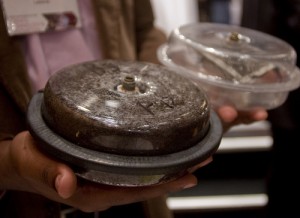
Image: National Geographic

Jason deCaires Taylor, a British sculptor based in Mexico, has created an underwater art installation. 400 permanent sculptures have been placed at the bottom of the ocean in the National Marine Park of Cancun. The work is called “Silent Evolution”.
See the video here
The work is really interesting because it will never be finished. Taylor continues to create more figures to add but because organisms will be living on and around it they will continue to change the appearance long after Taylor stops adding new pieces.
As part of MUSA (Museo Subacuatico de Arte, “Sub-aquatic Museum of Art”) the artificial reef was created in hopes of providing habitat for fish and many other species. The installation should also serve as a tourist attraction boosting business for snorkel and scuba charters in addition to diverting traffic away from the threatened natural reefs.
The sculptures are made using castings of real people, many of them locals. The final statues are made of a neutral pH, marine-grade cement. All the materials were tested for their impact on marine life prior to the installation.

Image: National Geographic
Since their placement in 2010, the sculptures have created a home for many fish species that have been absent from the area. The sculptures are already covered in a layer of algae and some coral, indicating that reef habitat will continue to grow. There has also already been a number of visiting snorkelers and scuba divers to the area.
It is great when artists think of the environment in their work. As a Scuba diver and an art enthusiast I would love to go see this in person. I think it sends a really important message about the danger the world’s coral reefs are in. Being in such a popular vacation spot should help spread the word of ocean and coral reef conservation.
Hopefully some scientists will monitor the site as an experiment to see when and how organisms like corals and algae attach themselves to rocks. These first settlers often determine which animals settle next and can affect the overall makeup of the reef community. It will be very interesting to see what kinds of life are there in a couple of years and what the sculptures look like. They may not even be recognizable!








